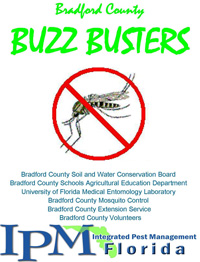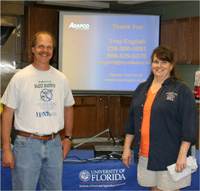Utilizing Volunteers to Implement Mosquito Control Integrated Pest Management (IPM) Practices in Bradford County Florida
What is it and what did we do?
Because the threat of mosquito borne diseases to humans and animals is ever present in Florida, it is critical that the most efficient and up to date methods are used to monitor and control mosquitoes. A team of volunteers and partners  including the Bradford County Extension Service, University of Florida, Florida Medical Entomology Laboratory, Bradford County Mosquito Control, Bradford County Soil and Water Conservation Board, Bradford County School Board (Agricultural Education Department) and Bradford County Citizen Volunteers was formed to assist county mosquito control efforts and to enhance public awareness regarding mosquito control. This program impacts those who are responsible for controlling mosquitoes in Bradford County and anyone who may contract a mosquito borne disease.
including the Bradford County Extension Service, University of Florida, Florida Medical Entomology Laboratory, Bradford County Mosquito Control, Bradford County Soil and Water Conservation Board, Bradford County School Board (Agricultural Education Department) and Bradford County Citizen Volunteers was formed to assist county mosquito control efforts and to enhance public awareness regarding mosquito control. This program impacts those who are responsible for controlling mosquitoes in Bradford County and anyone who may contract a mosquito borne disease.
What has been done?
Truly a community effort, this contributed to public awareness, education and application of IPM principles on mosquito control in Bradford County. Volunteers donated 105 hours at the Bradford County Fair and Starke Strawberry Festival to teach 702 citizens about IPM and mosquito control. Additional infomercials were realized through print and radio media (two newspaper articles for 11,650 circulation contacts and thirty-five one minute radio spots for 21,000 contacts).
The volunteer group “BUZZ BUSTERS” implemented IPM stratgies by collecting larvae and adult mosquitoes for identification and quantification by the Florida Medical Entomology Lab. The Buzz Busters donated over 500 hours collecting samples in 12 of 16 zones in Bradford County (representing 215 of 292 square  miles). The volunteers worked under a certified mosquito control applicator so they could apply B.t.i. (a bacterial strain used specifically for the control of mosquito larvae) and Agnique (a surface film that prevents adult mosquito emergence from the aquatic habitat) when surveillance indicated that the timing was appropriate for these methods. Between July and October 2007, the Bradford County Mosquito Control was notified 22 times that certain zones needed spraying when mosquito populations reached critical thresholds.
miles). The volunteers worked under a certified mosquito control applicator so they could apply B.t.i. (a bacterial strain used specifically for the control of mosquito larvae) and Agnique (a surface film that prevents adult mosquito emergence from the aquatic habitat) when surveillance indicated that the timing was appropriate for these methods. Between July and October 2007, the Bradford County Mosquito Control was notified 22 times that certain zones needed spraying when mosquito populations reached critical thresholds.
Additional outreach was done at two Bradford County public schools. Gambusia minnows were raised with the assistance of Bradford High School at the  agricultural farm. The minnows provided learning opportunities in the classroom and were used for biological control of mosquito larvae throughout the county where appropriate. A third grade class at Starke Elementary maintained an adult trap for three weeks, allowing the children to trap and identify mosquitoes. Their experience was also shared with the entire third grade class.
agricultural farm. The minnows provided learning opportunities in the classroom and were used for biological control of mosquito larvae throughout the county where appropriate. A third grade class at Starke Elementary maintained an adult trap for three weeks, allowing the children to trap and identify mosquitoes. Their experience was also shared with the entire third grade class.
What is the impact?
Because mosquitoes transmit diseases to both humans and livestock, the Buzz Buster’s impact is far reaching in terms of decreasing human and animal health risks. The volunteer’s immediately reduce the threat of disease transmission whenever they apply larvicides in the field. In mosquito management, using larvicides also decreases environmental risk since it reduces the amount of broad spectrum insecticides that are sprayed into the air to control adult mosquitoes. Because it is more expensive to kill adult mosquitoes, treating larvae also saves money. At the end of the mosquito season the data will be analyzed for significant findings regarding mosquito population planning and cost analysis on local and state levels.
The person that made this happen:
- Jim DeValerio,
Agricultural Extension Agent,
Bradford County Cooperative Extension Service